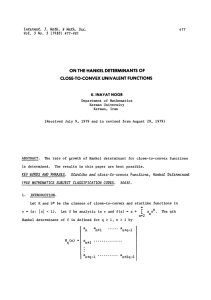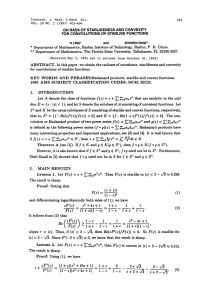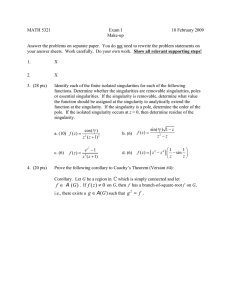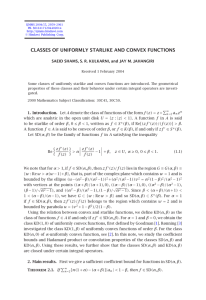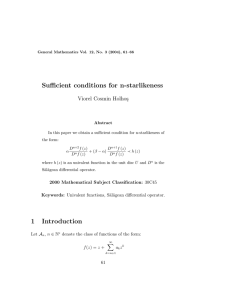p α 1 Introduction
advertisement
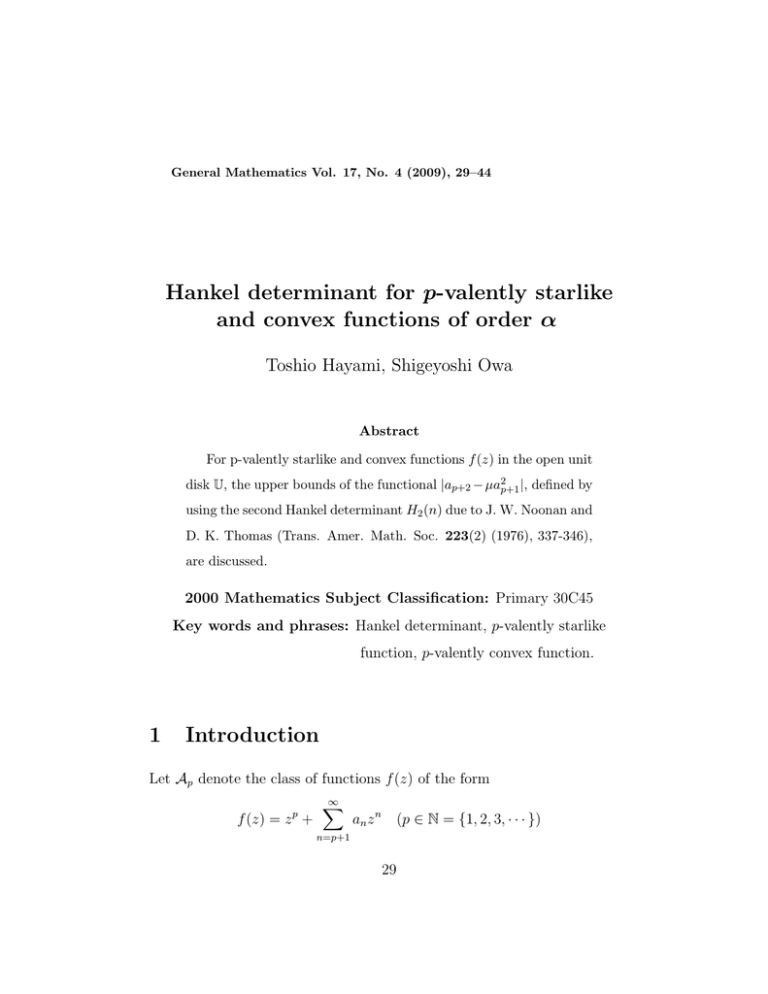
General Mathematics Vol. 17, No. 4 (2009), 29–44
Hankel determinant for p-valently starlike
and convex functions of order α
Toshio Hayami, Shigeyoshi Owa
Abstract
For p-valently starlike and convex functions f (z) in the open unit
disk U, the upper bounds of the functional |ap+2 − µa2p+1 |, defined by
using the second Hankel determinant H2 (n) due to J. W. Noonan and
D. K. Thomas (Trans. Amer. Math. Soc. 223(2) (1976), 337-346),
are discussed.
2000 Mathematics Subject Classification: Primary 30C45
Key words and phrases: Hankel determinant, p-valently starlike
function, p-valently convex function.
1
Introduction
Let Ap denote the class of functions f (z) of the form
p
f (z) = z +
∞
X
an z n
(p ∈ N = {1, 2, 3, · · · })
n=p+1
29
30
Toshio Hayami, Shigeyoshi Owa
which are analytic in the open unit disk U = {z ∈ C : |z| < 1}.
Furthermore, let P denote the class of functions p(z) of the form
p(z) = 1 +
∞
X
ck z k
k=1
which are analytic in U and satisfy
Re p(z) > 0
(z ∈ U).
Then we say that p(z) ∈ P is the Carathéodory function (cf. [1]).
If f (z) ∈ Ap satisfies the following condition
µ 0 ¶
zf (z)
Re
> α (z ∈ U)
f (z)
for some α (0 5 α < p), then f (z) is said to be p-valently starlike of order
α in U. We denote by Sp∗ (α) the subclass of Ap consisting of functions f (z)
which are p-valently starlike of order α in U. Similarly, we say that f (z)
belongs to the class Kp (α) of p-valently convex functions of order α in U if
f (z) ∈ Ap satisfies the following inequality
µ
¶
zf 00 (z)
> α (z ∈ U)
Re 1 + 0
f (z)
for some α (0 5 α < p).
As usual, in the present investigation, we write
Sp∗ = Sp∗ (0),
Kp = Kp (0),
S ∗ (α) = S1∗ (α) and K(α) = K1 (α).
Hankel determinant for p-valently starlike and convex functions . . .
Remark 1.
31
For a function f (z) ∈ Ap , it follows that
zf 0 (z)
∈ Sp∗ (α)
p
f (z) ∈ Kp (α) if and only if
and
Z
f (z) ∈
Sp∗ (α)
z
if and only if
0
pf (ζ)
dζ ∈ Kp (α).
ζ
Example 1.
f (z) =
zp
∈ Sp∗ (α)
(1 − z)2(p−α)
and
f (z) = z p 2 F1 (2(p − α), p; p + 1; z) ∈ Kp (α)
where 2 F1 (a, b; c; z) represents the hypergeometric function.
In [7], Noonan and
an
an+1
Hq (n) = det
..
.
an+q−1
Thomas stated the q–th Hankel determinant as
an+1 · · · an+q−1
an+2 · · ·
an+q
(n, q ∈ N = {1, 2, 3, · · · }).
..
..
..
.
.
.
an+q · · · an+2q−2
This determinant is discussed by several authors. For example, we can
know that the Fekete and Szegö functional |a3 − a22 | = |H2 (1)| and they
consider the further generalized functional |a3 − µa22 |, where µ is some real
number (see, [2]). Moreover, we also know that the functional |a2 a4 − a23 | is
equivalent to |H2 (2)|.
Janteng, Halim and Darus [4] have shown the following theorems.
32
Toshio Hayami, Shigeyoshi Owa
Theorem 1.
Let f (z) ∈ S ∗ . Then
|a2 a4 − a23 | 5 1.
Equality is attained for functions
f (z) =
z
= z + 2z 2 + 3z 3 + 4z 4 + · · ·
(1 − z)2
and
f (z) =
Theorem 2.
z
= z + z3 + z5 + z7 + · · · .
1 − z2
Let f (z) ∈ K. Then
1
|a2 a4 − a23 | 5 .
8
The present paper is motivated by these results and the purpose of
this investigation is to find the upper bounds of the generalized functional
|ap+2 −µa2p+1 |, defined by the second Hankel determinant, for functions f (z)
in the class Sp∗ (α) and Kp (α), respectively.
2
Preliminary results
In order to discuss our problems, we need some lemmas. The following
lemma can be found in [1] or [8].
Lemma 1.
If a function p(z) = 1 +
∞
P
ck z k ∈ P, then
k=1
|ck | 5 2 (k = 1, 2, 3, · · · ).
Hankel determinant for p-valently starlike and convex functions . . .
33
The result is sharp for
∞
X
1+z
=1+
2z k .
p(z) =
1−z
k=1
Using the above, we derive
Lemma 2.
If a function p(z) = p +
∞
P
ck z k satisfies the following in-
k=1
equality
Re p(z) > α
(z ∈ U)
for some α (0 5 α < p), then
(1)
|ck | 5 2(p − α) (k = 1, 2, 3, · · · ).
The result is sharp for
∞
X
p + (p − 2α)z
p(z) =
2(p − α)z k .
=p+
1−z
k=1
∞
P
p(z) − α
ck k
= 1+
z . Noting that q(z) ∈ P
p−α
k=1 p − α
and using Lemma 1, we see that
Proof. Let q(z) =
¯
¯
¯ ck ¯
¯
¯
¯ p − α ¯ 5 2 (k = 1, 2, 3, · · · )
which implies
|ck | 5 2(p − α) (k = 1, 2, 3, · · · ).
34
Toshio Hayami, Shigeyoshi Owa
Lemma 3.
The power series for p(z) = 1 +
∞
P
ck z k converges in U to a
k=1
function in P if and only if the Toeplitz determinants
¯
¯
¯
¯
¯ 2
c2
· · · cn ¯
c1
¯
¯
¯
¯
¯ c−1
2
c1
· · · cn−1 ¯
¯
¯
¯
¯
Dn = ¯ c−2 c−1
2
· · · cn−2 ¯ (n = 1, 2, 3, · · · ),
¯
¯
¯ ..
..
..
.. ¯
..
.
¯ .
.
.
. ¯
¯
¯
¯
¯
¯ c−n c−n+1 c−n+2 · · ·
2 ¯
where c−k = ck , are all non-negative. They are strictly positive except for
m
P
p(z) =
ρk p0 (eitk z), ρk > 0, tk real and tk 6= tj for k 6= j, where p0 (z) =
k=1
1+z
; in this case Dn > 0 for n < m − 1 and Dn = 0 for n = m.
1−z
This necessary and sufficient condition is due to Carathéodory and
Toeplitz, and it can be found in [3]. And then, Libera and Zl/otkiewicz
[5] (see, also [6]) have given the following result by using this lemma with
n = 2, 3.
Lemma 4.
If a function p(z) ∈ P, then the representations
2c = c2 + (4 − c2 )ζ
2
1
1
4c = c3 + 2(4 − c2 )c ζ − (4 − c2 )c ζ 2 + 2(4 − c2 )(1 − |ζ|2 )η
3
1
1 1
1 1
1
for some complex numbers ζ and η (|ζ| 5 1, |η| 5 1), are obtained.
By virtue of Lemma 4, we have
Hankel determinant for p-valently starlike and convex functions . . .
Lemma 5.
If a function p(z) = p+
ck z k satisfies Re p(z) > α (z ∈ U)
k=1
for some α (0 5 α < p), then
(2)
∞
P
35
2(p − α)c2 = c21 + {4(p − α)2 − c21 }ζ
4(p − α)2 c3 = c31 + 2{4(p − α)2 − c21 }c1 ζ − {4(p − α)2 − c21 }c1 ζ 2
+2(p − α){4(p − α)2 − c21 }(1 − |ζ|2 )η
for some complex numbers ζ and η (|ζ| 5 1, |η| 5 1).
∞
P
p(z) − α
ck k
Proof. Since q(z) =
=1+
z ∈ P, replacing c2 and
p−α
k=1 p − α
c2
c3
c3 by
and
in Lemma 4, respectively, we immediately have the
p−α
p−α
relations of the lemma.
We also need the next remark.
Remark 2. If f (z) ∈ Sp∗ (α), then there exists a function p(z) = p +
∞
P
ck z k such that Re p(z) > α (z ∈ U) and
k=1
zf 0 (z) = f (z)p(z)
which implies that
p+
∞
X
nan z n−p = p +
∞
X
n=p+1
n=p+1
à n
X
!
al cn−l
z n−p
l=p
where ap = 1 and c0 = p. Therefore, we have the follwing relation
(3)
(n − p)an =
n−1
X
l=p
al cn−l
(n = p + 1).
36
3
Toshio Hayami, Shigeyoshi Owa
Main results
In this section, we begin with the upper bound of |ap+2 −µa2p+1 | for p-valently
starlike functions of order α below.
Theorem 3.
If a function f (z) ∈ Sp∗ (α) (0 5 α < p), then
µ
¶
1
(p − α) {(2(p − α) + 1) − 4(p − α)µ}
µ5
2
µ
¶
1
p+1−α
2
|ap+2 −µap+1 | 5
p−α
5µ5
2
2(p − α)
µ
¶
p+1−α
µ=
(p − α) {4(p − α)µ − (2(p − α) + 1)}
2(p − α)
with equality for
zp
2(p−α)
(1 − z)
f (z) =
zp
(1 − z 2 )p−α
µ
µ
p+1−α
1
µ 5 or µ =
2
2(p − α)
1
p+1−α
5µ5
2
2(p − α)
¶
¶
.
Proof. If f (z) ∈ Sp∗ (α), then we have the equation (3) which means
c2 + c21
that ap+1 = c1 and ap+2 =
. Thus, by the inequality (1) and the
2
representation (2), we can suppose that c1 = c (0 5 c 5 2(p − α)) without
Hankel determinant for p-valently starlike and convex functions . . .
37
loss of generality and we derive
¯
¯
¯ c2 + c2
¯
2
2
|ap+2 − µap+1 | = ¯¯
− µc ¯¯
2
¯
¯
c2 + {4(p − α)2 − c2 }ζ ¯¯
1 ¯¯
2
(1 − 2µ)c +
=
¯
2¯
2(p − α)
=
1
|{2(p − α) − 4(p − α)µ + 1}c2 + {4(p − α)2 − c2 }ζ|
4(p − α)
≡ A(ζ).
Applying the triangle inequality, we deduce
£
¤
1
|(2(p − α) + 1) − 4(p − α)µ| c2 + {4(p − α)2 − c2 }
4(p − α)
µ
¶
1
2(p − α) + 1
2
2
[2(p − α)(1 − 2µ)c + 4(p − α) ]
µ5
4(p − α)
4(p − α)
A(ζ) 5
=
5
µ
¶
1
2(p
−
α)
+
1
2
2
[2{2(p − α)µ − (p + 1 − α)}c + 4(p − α) ] µ =
4(p − α)
4(p − α)
¶
µ
1
(p − α) {(2(p − α) + 1) − 4(p − α)µ}
µ 5 , c = 2(p − α)
2
µ
¶
1
2(p − α) + 1
p−α
5µ5
,c = 0
2
4(p − α)
µ
¶
2(p
−
α)
+
1
p
+
1
−
α
p−α
5µ5
,c = 0
4(p − α)
2(p − α)
¶
µ
p+1−α
, c = 2(p − α) .
µ=
(p − α) {4(p − α)µ − (2(p − α) + 1)}
2(p − α)
38
Toshio Hayami, Shigeyoshi Owa
Equality is attained for functions f (z) ∈ Sp∗ (α) defined by
zf 0 (z)
p + (p − 2α)z
= p(z) =
f (z)
1−z
for the case c1 = c = 2(p − α), ζ = 1 and c2 = 2(p − α), or
zf 0 (z)
p + (p − 2α)z 2
= p(z) =
f (z)
1 − z2
for the case c1 = c = 0, ζ = 1 and c2 = 2(p − α).
Taking α = 0 or p = 1 in Theorem 3, we obtain the following corollaries,
respectively.
If a function f (z) ∈ Sp∗ , then
Corollary 1.
µ
¶
1
p {(2p + 1) − 4pµ}
µ5
2
µ
¶
1
p+1
2
p
5µ5
|ap+2 − µap+1 | 5
2
2p
µ
¶
p+1
µ=
p {4pµ − (2p + 1)}
2p
with equality for
f (z) =
zp
2p
(1 − z)
µ
µ
zp
(1 − z 2 )p
1
p+1
µ 5 or µ =
2
2p
1
p+1
5µ5
2
2p
¶
.
¶
Hankel determinant for p-valently starlike and convex functions . . .
If a function f (z) ∈ S ∗ (α), then
¶
µ
1
µ5
(1 − α) {(3 − 2α) − 4(1 − α)µ}
2
µ
¶
1
2−α
2
|a3 − µa2 | 5
1−α
5µ5
2
2(1 − α)
¶
µ
2
−
α
µ=
(1 − α) {4(1 − α)µ − (3 − 2α)}
2(1 − α)
with equality for
µ
¶
z
1
2
−
α
µ 5 or µ =
2(1−α)
2
2(1 − α)
(1 − z)
f (z) =
¶
µ
z
1
2−α
5µ5
.
(1 − z 2 )1−α
2
2(1 − α)
Corollary 2.
Also, by Corollary 1 and Corollary 2, we readily know
Corollary 3.
If a function f (z) ∈ S ∗ ,
3 − 4µ
2
|a3 − µa2 | 5
1
4µ − 3
with equality for
f (z) =
z
2
(1 − z)
µ
µ
z
1 − z2
then
µ
¶
1
µ5
2
µ
¶
1
5µ51
2
(µ = 1)
1
µ 5 or µ = 1
2
¶
1
5µ51 .
2
¶
39
40
Toshio Hayami, Shigeyoshi Owa
Next, in consideration of Remark 1, we derive the upper bounds of
|ap+2 − µa2p+1 | for p-valently convex functions.
Theorem 4.
If a function f (z) ∈ Kp (α) (0 5 α < p), then
|ap+2 − µa2p+1 | 5
µ
¶
2
2
p(p
−
α)
{(2(p
−
α)
+
1)(p
+
1)
−
4(p
−
α)p(p
+
2)µ}
(p
+
1)
µ5
(p + 1)2 (p + 2)
2p(p + 2)
µ
¶
p(p − α)
(p + 1)2
(p + 1)2 (p + 1 − α)
5µ5
p+2
2p(p + 2)
2p(p + 2)(p − α)
p(p − α) {4(p − α)p(p + 2)µ − (2(p − α) + 1)(p + 1)2 }
(p + 1)2 (p + 2) µ
¶
(p + 1)2 (p + 1 − α)
µ=
2p(p + 2)(p − α)
with equality for
µ
¶
2
2
(p
+
1)
(p
+
1)
(p
+
1
−
α)
z p 2 F1 (2(p − α), p; p + 1; z) µ 5
or µ =
2p(p + 2)
2p(p + 2)(p − α)
f (z) =
¶
µ
³p
p 2´
(p + 1)2
(p + 1)2 (p + 1 − α)
p
5µ5
.
z 2 F1 , p − α; 1 + ; z
2
2
2p(p + 2)
2p(p + 2)(p − α)
Proof. Noting that f (z) ∈ Kp (α) if and only if
Hankel determinant for p-valently starlike and convex functions . . .
41
∞
P
zf 0 (z)
n
= zp +
an z n ∈ Sp∗ (α) and using Theorem 3, we see that
p
n=p+1 p
(p − α) {(2(p − α) + 1) − 4(p − α)ν}
¯
¯
2
¯
¯p + 2
(p
+
1)
2 ¯
¯
p−α
¯ p ap+2 − ν p2 ap+1 ¯ 5
(p − α) {4(p − α)ν − (2(p − α) + 1)} ,
¯
¯
2
¯
¯
(p
+
1)
2
that is, that ¯¯ap+2 −
νap+1 ¯¯ 5
p(p + 2)
µ
¶
p(p − α) {(2(p − α) + 1) − 4(p − α)ν}
1
ν5
p+2
2
µ
¶
p(p − α)
1
p+1−α
5ν5
p+2
2
2(p − α)
µ
¶
p(p − α) {4(p − α)ν − (2(p − α) + 1)}
p+1−α
ν=
.
p+2
2(p − α)
Now, putting
(p + 1)2
ν = µ, the proof of the theorem is completed.
p(p + 2)
When α = 0 or p = 1 in Theorem 4, the following three corollaries are
obtained.
42
Toshio Hayami, Shigeyoshi Owa
Corollary 4.
If a function f (z) ∈ Kp , then
2
µ
¶
2
2
2
(p
+
1)
p
{(2p
+
1)(p
+
1)
−
4p
(p
+
2)µ}
µ5
(p + 1)2 (p + 2)
2p(p + 2)
µ
¶
p2
(p + 1)2
(p + 1)3
2
|ap+2 −µap+1 | 5
5µ5 2
p+2
2p(p + 2)
2p (p + 2)
µ
¶
p2 {4p2 (p + 2)µ − (2p + 1)(p + 1)2 }
(p + 1)3
µ= 2
(p + 1)2 (p + 2)
2p (p + 2)
with equality for
z p 2 F1 (2p, p; p + 1; z)
f (z) =
³p
p ´
z p 2 F1 , p; 1 + ; z 2
2
2
µ
µ
(p + 1)2
(p + 1)3
µ5
or µ = 2
2p(p + 2)
2p (p + 2)
(p + 1)2
(p + 1)3
5µ5 2
2p(p + 2)
2p (p + 2)
¶
¶
.
If a function f (z) ∈ K(α), then
µ
¶
(1
−
α)
2
{(3 − 2α) − 3(1 − α)µ}
µ5
3
3
µ
¶
2
1−α
2(2 − α)
2
|a3 − µa2 | 5
5µ5
3
3
3(1 − α)
µ
¶
(1
−
α)
2(2
−
α)
{3(1 − α)µ − (3 − 2α)}
µ=
3
3(1 − α)
Corollary 5.
with equality for
µ
¶ µ
¶
1
2(2 − α)
2
1 − (1 − z)2α−1
and log
µ 5 or µ =
2α − 1
1−z
3
3(1 − α)
f (z) =
¶
µ
µ
¶
3
2
2(2
−
α)
1
2
, 1 − α; ; z
5µ5
.
z 2 F1
2
2
3
3(1 − α)
Hankel determinant for p-valently starlike and convex functions . . .
Corollary 6.
If a function f (z) ∈ K,
1−µ
1
2
|a3 − µa2 | 5
3
µ−1
43
then
¶
µ
2
µ5
3
µ
µ
2
4
5µ5
3
3
4
µ=
3
¶
¶
with equality for
f (z) =
z
1−z
µ
¶
1
+
z
1
log
2
1−z
µ
µ
2
4
µ 5 or µ =
3
3
2
4
5µ5
3
3
¶
¶
.
References
[1] P. L. Duren, Univalent Functions, Springer-Verlag, New York, Berlin,
Heidelberg, Tokyo, 1983.
[2] M. Fekete and G. Szegö, Eine Bemerkung uber ungerade schlichte Funktionen, J. London Math. Soc. 8(1933), 85-89.
[3] U. Grenander and G. Szegö, Toeplitz Forms and their Applications,
Univ. of California Press, Berkeley and Los Angeles, (1958).
[4] A. Janteng, S. A. Halim and M. Darus, Hankel determinant for starlike
and convex functions, Int. Journal of Math. Anal. 1(2007), 619-625.
44
Toshio Hayami, Shigeyoshi Owa
[5] R. J. Libera and E. J. Zl/otkiewicz, Early coefficients of the inverse of a
regular convex function, Proc. Amer. Math. Soc. 85(1982), 225-230.
[6] R. J. Libera and E. J. Zl/otkiewicz, Coefficient bounds for the inverse
of a function with derivative in P, Proc. Amer. Math. Soc. 87(1983),
251-257.
[7] J. W. Noonan and D. K. Thomas, On the second Hankel determinant of
areally mean p-valent functions, Trans. Amer. Math. Soc. 223(2) (1976),
337-346.
[8] Ch. Pommerenke, Univalent Functions, Vandenhoeck and Ruprecht,
Göttingen, (1975).
Toshio Hayami
Kinki University
Department of Mathematics
Higashi-Osaka, Osaka 577-8502, Japan
e-mail: ha ya to112@hotmail.com
Shigeyoshi Owa
Kinki University
Department of Mathematics
Higashi-Osaka, Osaka 577-8502, Japan
e-mail: owa@math.kindai.ac.jp
